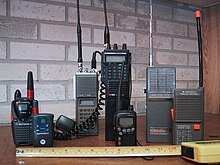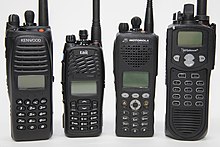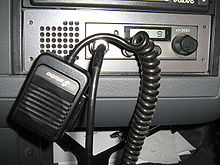
Two-way radio
This article needs additional citations for verification. (July 2022) |


A two-way radio is a radio transceiver (a radio that can both transmit and receive radio waves), which is used for bidirectional person-to-person voice communication with other users with similar radios,[1] in contrast to a broadcast receiver, which only receives transmissions.

Two-way radios usually use a half-duplex communication channel, which permits two-way communication, albeit with the limitation that only one user can transmit at a time. (This is in contrast to simplex communication, in which transmission can only be sent in one direction, and full-duplex, which allows transmission in both directions simultaneously.) This requires users in a group to take turns talking. The radio is normally in receive mode so the user can hear all other transmissions on the channel. When the user wants to talk, they press a "push-to-talk" button, which turns off the receiver and turns on the transmitter; when the button is released, the receiver is activated again. Multiple channels are provided so separate user groups can communicate in the same area without interfering with each other and some radios are designed to scan the channels in order to find a valid transmission. Other two-way radio systems operate in full-duplex mode, in which both parties can talk simultaneously. This requires either two separate radio channels or channel sharing methods such as time-division duplex (TDD) to carry the two directions of the conversation simultaneously on a single radio frequency.[2]

The first two-way radio was an AM-only device introduced by the Galvin Manufacturing Corporation in 1940 for use by the police and military during World War II, and followed by the company's 1943 introduction of the Walkie-Talkie,[3] the best-known example of a two-way radio.[4]

History


The first truly mobile two-way radio equipment was developed in Australia in 1923 by Senior Constable Frederick William Downie of the Victorian Police. The Victoria Police were the first in the world to use wireless communication in cars, putting an end to the inefficient status reports via public telephone boxes which had been used until that time. The first sets occupied about half of the floor in the back seat of the Lancia patrol cars.[5]

In 1933, the Bayonne, New Jersey police department successfully operated a two-way system between a central fixed station and radio transceivers installed in police cars; this allowed rapidly directing police response in emergencies.[6]

Types


Two-way radio systems can be classified in several ways depending on their attributes.

Conventional versus trunked
Conventional
In multi-channel systems, channels are used for separate purposes.[7]

Scanning in conventional radios
Scan features are either not used or scan lists are intentionally kept short in emergency applications. Part of APCO Project 16 set standards for channel access times and delays caused by system overhead. Scan features can further increase these delays. One study said delays of longer than 0.4 seconds (400 milliseconds) in emergency services are not recommended.[8]

Duplex
The term "half duplex" is applied to wired communication systems where the circuit can send information in one direction at a time but not both directions at the same time.[9]

- Advantage: duplex channels usually allow repeater operation which extends range (in most cases due to increased transmit power and improved aerial location / height) – especially where hand-held radios are in use.
- Disadvantage: If a radio cannot reach the repeater, it cannot communicate. This can be mitigated with a "talk around" or "car to car" setting where stations out of range of the base can speak directly to each other, alternating transmitting and receiving roles in simplex fashion on a single frequency.[10]
Analog
Analog systems may communicate a single condition, such as water level in a livestock tank. A transmitter at the tank site continually sends a signal with a constant audio tone. The tone would change in pitch to indicate the tank's water level. A meter at the remote end would vary, corresponding to the tone pitch, to indicate the amount of water present in the livestock tank. Similar methods can be used to telemeter any analog condition. This type of radio system serves a purpose equivalent to a four-to-twenty milliampere loop.[11] In the US, mid-band 72–76 MHz or UHF 450–470 MHz interstitial channels are often used for these systems. Some systems multiplex telemetry of several analog conditions by limiting each to a separate range of tone pitches, for example.[12]

Digital
Digital systems may communicate text messages from computer-aided dispatch (CAD). For example, a display in a tow truck may give a textual location for a call and any related details. The tow truck driver may press an acknowledge button, sending data in the opposite direction and flagging the call as received by the driver. They can be used for analog telemetry systems, such as the livestock tank levels, as described above. Another possibility is the lubricating oil pressure in a transit bus engine, or the current speed of the bus. Analog conditions are translated into data words. Some systems send radio paging messages which can either 1) beep a paging receiver, 2) send a numeric message, or 3) send a text message.[13]

Engineered versus not engineered
Engineered systems are designed to perform close to a specification or standard.[citation needed] They are designed as systems with all equipment matched to perform together. For example, a modern, local government two-way radio system in the US may be designed to provide 95% area coverage in an urban area. System designers use radio frequency models, terrain models, and signal propagation modeling software in an attempt to accurately estimate where radios will work within a defined geographic area. The models help designers choose equipment, equipment locations, antennas, and estimate how well signals will penetrate buildings. These models will be backed-up by drive testing and actual field signal level measurements. Designers adjust antenna patterns, add or move equipment sites, and design antenna networks in a way that will accomplish the intended level of performance.[14]

Options, duty cycle, and configuration

Many mobile and handhelds have a limited duty cycle. Duty Cycle is the ratio of listening time to transmit time and is generally dependent on how well the transmitter can shed the heat from the heat sink on the rear of the radio. A 10% duty cycle (common on handhelds) translates to 10 seconds of transmit time to 90 seconds of receive time. Some mobile and base equipment is specified at different power levels – for example 100% duty cycle at 25 watts and 15% at 40 watts.[15]


Life of equipment
In government systems, equipment may be replaced based on budgeting rather than any plan or expected service life. Funding in government agencies may be cyclical or sporadic. Managers may replace computing systems, vehicles, or budget computer and vehicle support costs while ignoring two-way radio equipment. Equipment may remain in use even though maintenance costs are unreasonable when viewed from an efficiency standpoint.[16]

One document says "seven years" is beyond the expected lifetime of walkie-talkies in police service. Batteries are cited as needing replacement more often. Twelve-year-old dispatch consoles mentioned in the same document were identified as usable. These were compared to problematic 21-year-old consoles used elsewhere in the same system.[17]

Another source says system backbone equipment like consoles and base stations are expected to have a fifteen-year life. Mobile radios are expected to last ten years. Walkie talkies typically last eight.[18] In a State of California document, the Department of General Services reports expected service life for a communications console used in the Department of Forestry and Fire Protection is 10 years.[19]

Two-way radio frequencies
The examples and perspective in this section deal primarily with the United States and do not represent a worldwide view of the subject. (October 2012) |

Typical two-way radios work on fixed radio frequency channels, though some can scan multiple channels in order to find a valid transmission.[4][unreliable source?] In an analog, conventional system, (the simplest type of system) a frequency or channel serves as a physical medium or link carrying communicated information. The performance of a radio system is partly dependent on the characteristics of frequency band used. The selection of a frequency for a two-way radio system is affected, in part, by:[20]

- government licensing and regulations.
- local congestion or availability of frequencies.
- terrain, since radio signals travel differently in forests and urban viewsheds.
- the presence of noise, interference, or intermodulation.
- sky wave interference below 50–60 MHz and tropospheric bending at VHF.
- in the US, some frequencies require approval of a frequency coordination committee.[20]
UHF versus VHF
The most common two-way radio systems operate in the VHF and UHF parts of the radio spectrum. Because this part of the spectrum is heavily used for broadcasting and multiple competing uses, spectrum management has become an important activity of governments to regulate radio users in the interests of both efficient and non-interfering use of radio. Both bands are widely applied for different users.[21]

Range
The useful direct range of a two-way radio system depends on radio propagation conditions, which are a function of frequency.[22]

There are other factors that affect the range of a two-way radio such as weather, exact frequency used, and obstructions.[22][23]

See also
- TETRA (Terrestrial Trunked Radio)
- Astro (Motorola)
- Digital Mobile Radio
- PMR446
- Family Radio Service
- GE Marc V
- Project 25
- Quik Call I
- Motorola Saber
- Mobile radio
- Police radio
- Radiotelephony
References
- ^ Graf, Rudolf F. (1999). Modern Dictionary of Electronics, 7th Ed. Elsevier. p. 811. ISBN 9780080511986.
- ^ Goldsmith, Andrea (8 Aug 2005). Wireless Communications. Cambridge University Press. ISBN 9780521837163. Retrieved 20 April 2016.
- ^ Hall, Mark (October 3, 2022). "Motorola, Inc.". Encyclopædia Britannica. Archived from the original on January 18, 2023. Retrieved January 17, 2022.
- ^ a b "A complete guide to Two-way Radios". Crystal Radio Systems Ltd. Archived from the original on June 26, 2022. Retrieved January 17, 2023.
- ^ Haldane, Robert. (1995) The People's Force, A history of the Victoria Police. Melbourne University Press. ISBN 0-522-84674-2, 1995
- ^ IEEE History Milestones retrieved Oct. 2, 2007
- ^ One example of purpose-specific channel assignments is described in Ivanov, D. A., V. P. Savelyev, and P. V. Shemanski, "Organization of Communications," Fundamentals of Tactical Command and Control: A Soviet View, Soviet Military Thought Series #18, (Washington, D.C.: Superintendent of Documents, 1977) Library of Congress Control Number: 84602565. This is a US Air Force translation of a Soviet-era, Russian-language book. See also, "Inadequate System Capacity," Special Report: Improving Firefighter Communications, USFA-TR-099/January 1999, (Emmitsburg, Maryland: U.S. Fire Administration, 1999) pp. 18-19 and "5.2 Present System," The California Highway Patrol Communications Technology Research Project on 800 MHz, 80-C477, (Sacramento, California: Department of General Services, Communications Technology Division, 1982,) pp. V-4 - V-6.
- ^ "3.4.1 User Equipment General Deficiencies," San Rafael Police Radio Committee: Report to Mayor and City Council, (San Rafael, California: City of San Rafael, 1995,) pp. 12.
- ^ "IEEE 100 The Authoritative Dictionary of IEEE Standards Terms", Seventh Edition, IEEE Press, 2000, ISBN SBN 0-7381 -2601 -2
- ^ For an example of talk around use, see "Problem Reporting," Special Report: Improving Firefighter Communications, USFA-TR-099/January 1999, (Emmitsburg, Maryland: U.S. Fire Administration, 1999) pp. 25-26. This article also confirms the definition of the phrase talk around.
- ^ For examples, see, Mikhailov, K. E. "Communications Facilities on the Volga-Moscow Transmission Line," Long-Distance Electrical Transmission between the V. I. Lenin Hydroelectric Station and Moscow, (Jerusalem: Israeli Program for Scientific Translations, 1965).
- ^ For an electrocardiogram telemetry example, see Planning Emergency Medical Communications: Volume 2, Local/Regional-Level Planning Guide, (Washington, D.C.: National Highway Traffic Safety Administration, US Department of Transportation, 1995) pp. 48.
- ^ "Spartan Training Bulletin - Volume One – Issue One". Retrieved October 18, 2017.
- ^ For two examples of drive testing and field measurements of received signal levels, see:
- "Section II: Radio Propagation Studies," The California Highway Patrol Communications Technology Research Project on 800 MHz, 80-C477, (Sacramento, California: Department of General Services, Communications Technology Division, 1982,) pp. II-1 - II-34.
- Ossanna, Jr., Joseph F., "A Model For Mobile Radio Fading Due to Building Reflections: Theoretical and Experimental Fading Waveform Power Spectra," Bell System Technical Journal, November 1964, pp. 2935-2971. 800 MHz trivia: this article shows that signal fades occur at audio frequencies near CTCSS tones, explaining why only DCS was used in Motorola 800 MHz systems in the 1970s.
- ^ Kenwood TKR-850 specification sheet
- ^ For one example, see: "Plan Element S-7: Rationalized Funding" and "Plan Element L-2: Permanent Contra Costa Public Safety Radio Authority," Contra Costa County Public Safety Mobile Radio Master Plan, (Fairfax, Virginia: Federal Engineering, Inc., 2002,) pp. 45, 49.
- ^ For one example, see: "3.2.10.1 Current System Problems," Trunked Radio System: Request For Proposals, (Oklahoma City, Oklahoma: Oklahoma City Municipal Facilities Authority, Public Safety Capital Projects Office, 2000) pp. 56.
- ^ "2.4 Equipment Inventory," San Rafael Police Radio Committee: Report to Mayor and City Council, (San Rafael, California: City of San Rafael, 1995,) pp. 8.
- ^ "8000 Exhibits:Equipment Replacement Costs for a Typical Three Position CDF Command and Control Center," 8000 Telecommunications Manual, (Sacramento, California: State of California, Department of Forestry and Fire Protection, 2006) Adobe PDF file on console costs.
- ^ a b See, "Appendix B - FCC Regulations," California EMS Communications Plan: Final Draft, (Sacramento, California: State of California EMS Authority, September 2000) pp.38. and Arizona Phase II Final Report: Statewide Radio Inter-operability Needs Assessment, Macro Corporation and The State of Arizona, 2004.
- ^ "VHF or UHF... Which Is Better?"
- ^ a b Two Way Radio Range
- ^ "2-Way Radio Range: How Far Can Two-Way Radios Communicate?"
External links
See what we do next...
OR
By submitting your email or phone number, you're giving mschf permission to send you email and/or recurring marketing texts. Data rates may apply. Text stop to cancel, help for help.
Success: You're subscribed now !
